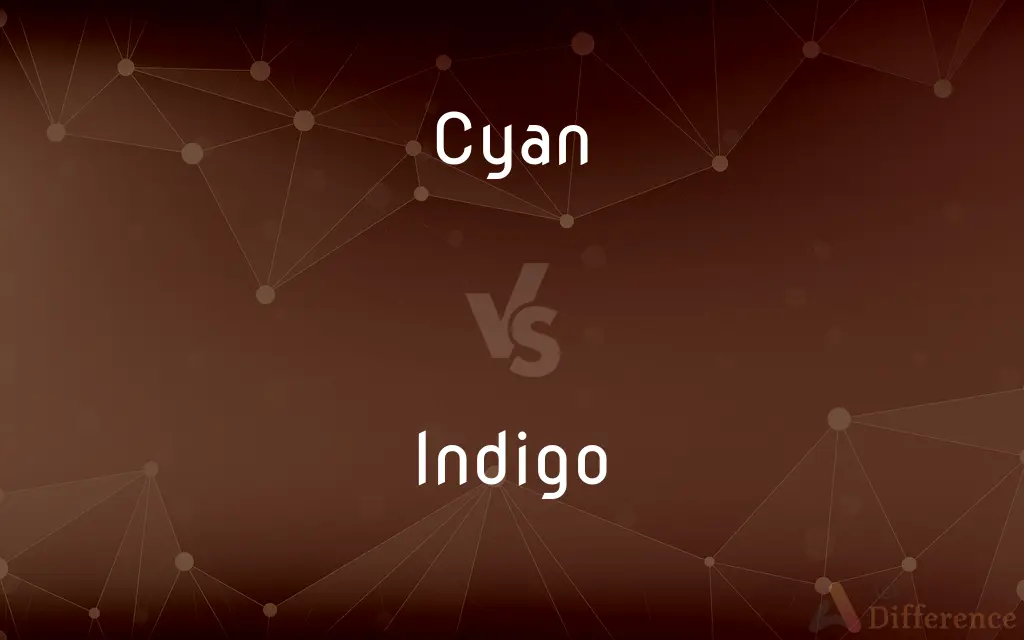Cyan vs. Indigo — What's the Difference?
By Tayyaba Rehman & Urooj Arif — Updated on March 18, 2024
Cyan is a bright, light blue color, often associated with water and sky, while indigo is a deep, dark blue, akin to the night sky.

Difference Between Cyan and Indigo
Table of Contents
ADVERTISEMENT
Key Differences
Cyan is a primary color in the subtractive color model, used in color printing, which appears as a light, vibrant shade of blue. It evokes feelings of freshness and tranquility, commonly used to represent water or sky in art and design. On the other hand, indigo is closer to violet on the color spectrum, a rich color that symbolizes depth and stability. It's often used to convey seriousness and sophistication.
Cyan is created by mixing equal parts of green and blue light in the RGB color model, resulting in a color that is bright and eye-catching. This makes it a popular choice for designers looking to create a vibrant, energetic feel. Indigo, however, is traditionally seen as one of the colors of the rainbow, positioned between blue and violet, and its exact hue can vary. It's a deeper, more subdued color compared to cyan, lending itself to more reserved or elegant applications.
In the realm of psychology, cyan is associated with calmness, serenity, and healing, making it a favored color in spaces designed for relaxation and healthcare. Indigo, with its darker tone, is often linked to intuition, perception, and increased concentration, preferred in environments meant to stimulate deep thinking or creativity.
Cyan ink is widely used in the printing industry, playing a crucial role in the CMYK color model by mixing with magenta and yellow to create a wide range of colors. Indigo's significance lies more in its historical and cultural context, particularly in textiles, where it has been used for centuries to dye fabric a deep blue.
Both colors have their place in branding and marketing, with cyan often chosen for brands that want to project an image of innovation, cleanliness, and precision. Indigo, however, is selected by brands that aim for a perception of reliability, wisdom, and depth, appealing to a more mature audience.
ADVERTISEMENT
Comparison Chart
Color Spectrum
Light, bright shade of blue
Deep, dark blue, closer to violet
Psychological Effect
Evokes calmness and freshness
Symbolizes depth, stability, and intuition
Common Uses
Water/sky representations, vibrant designs
Elegance in design, deep thinking environments
Color Mixing
Equal parts of green and blue in RGB model
Positioned between blue and violet
Significance
Key in CMYK printing, represents cleanliness
Historical/cultural importance in textiles
Compare with Definitions
Cyan
One of the primary colors in the subtractive color model.
Cyan ink is essential for color printing.
Indigo
A color on the spectrum between blue and violet.
She wore an indigo dress that matched the evening sky.
Cyan
A greenish-blue color.
The artist chose cyan for the sky to give the painting a lively feel.
Indigo
A color often used in branding for its sophistication.
The luxury brand's logo is indigo to convey elegance.
Cyan
A light, refreshing shade often used in design.
The room was painted cyan to create a calming effect.
Indigo
Symbolic of intuition and perception in psychology.
The indigo light in the installation evokes a sense of mystery.
Cyan
The color halfway between green and blue on the RGB color wheel.
The logo's cyan hue was chosen for its vibrancy.
Indigo
A dye originally derived from the indigo plant.
Indigo dye has been used for centuries in textile production.
Cyan
A color that represents water in many cultures.
In the mural, cyan was used to symbolize the river.
Indigo
Represents depth and concentration.
The study's walls were painted indigo to enhance focus.
Cyan
Cyan () is the color between green and blue on the visible spectrum of light. It is evoked by light with a predominant wavelength between 490 and 520 nm, between the wavelengths of green and blue.In the subtractive color system, or CMYK color model, which can be overlaid to produce all colors in paint and color printing, cyan is one of the primary colors, along with magenta and yellow.
Indigo
Indigo is a deep color close to the color wheel blue (a primary color in the RGB color space), as well as to some variants of ultramarine, based on the ancient dye of the same name. The word "indigo" comes from the Latin for Indian as the dye was originally exported to Europe from India.
Cyan
A greenish-blue colour which is one of the primary subtractive colours, complementary to red.
Indigo
Any of various shrubs or herbs of the genus Indigofera in the pea family, having pinnately compound leaves and usually red or purple flowers in axillary racemes.
Cyan
A greenish blue, one of the subtractive primary colors.
Indigo
A dark blue crystalline compound, C16H10N2O2, that is obtained from these plants or produced synthetically and is widely used as a textile dye. Also called indigotin.
Cyan
A vibrant pale greenish-blue colour between blue and green in the visible spectrum; the complementary colour of red; the colour obtained by subtracting red from white light.
Indigo
Any of several related plants, especially those of the genera Amorpha and Baptisia.
Cyan
Of the colour cyan.
Indigo
The hue of that portion of the visible spectrum lying between blue and violet, evoked in the human observer by radiant energy with wavelengths of approximately 420 to 450 nanometers; a dark blue to grayish purple blue.
Cyan
A blue-green that is one of the primary pigments
Indigo
A purplish-blue colour
Cyan
A bluish shade of green
Indigo
An indigo-colored dye obtained from certain plants (the indigo plant or woad), or a similar synthetic dye.
Indigo
An indigo plant, such as from species in genera Indigofera, Amorpha (false indigo), Baptisia (wild indigo), and Psorothamnus and Dalea (indigo bush).
Indigo
Having a deep purplish-blue colour
Indigo
A kind of deep blue, one of the seven prismatic colors.
Indigo
A blue dyestuff obtained from several plants belonging to very different genera and orders, such as, the woad, Isatis tinctoria (family Cruciferae), Indigofera suffroticosa, Indigofera tinctoria (family Leguminosae), Indigofera Anil, Nereum tinctorium, Polygonum tinctorium Ait. (family Polygonaceae), etc.; called also natural indigo. It is a dark blue earthy substance, tasteless and odorless, with a copper-violet luster when rubbed. Indigo does not exist in the plants as such, but is obtained by decomposition of the glycoside indican.
Indigo
Having the color of, pertaining to, or derived from, indigo.
Indigo
A blue dye obtained from plants or made synthetically
Indigo
Deciduous subshrub of southeastern Asia having pinnate leaves and clusters of red or purple flowers; a source of indigo dye
Indigo
A blue-violet color
Common Curiosities
Where is cyan commonly used?
Cyan is commonly used in art and design to represent water or sky and in the printing industry.
Where is indigo commonly used?
Indigo is used in textiles, deep thinking environments, and to convey sophistication in branding.
What is cyan?
Cyan is a bright, light blue color that is one of the primary colors in the subtractive color model.
What is indigo?
Indigo is a deep, dark blue color that lies between blue and violet on the color spectrum.
Why is cyan important in printing?
Cyan is crucial in the CMYK color model for creating a wide range of colors through mixing.
How do cyan and indigo differ in color psychology?
Cyan is associated with calmness and freshness, whereas indigo symbolizes depth, stability, and intuition.
How are cyan and indigo made?
Cyan is created by mixing green and blue light, while indigo's hue is naturally positioned between blue and violet.
Can cyan and indigo be used together in design?
Yes, cyan and indigo can complement each other in design, offering a range from vibrant to deep tones.
What does indigo represent in different cultures?
In many cultures, indigo is associated with wisdom, integrity, and deep contemplation.
Is indigo still made from natural sources?
While historically derived from the indigo plant, most indigo dye is now synthetically produced.
What industries rely heavily on cyan?
The printing and design industries rely heavily on cyan for its vibrancy and versatility.
Can cyan and indigo affect mood?
Yes, cyan is known to have a calming effect, while indigo can stimulate deeper thought and concentration.
How does indigo influence fashion?
Indigo has a long history in fashion, particularly in denim, where it is prized for its deep, rich blue.
How do lighting conditions affect the perception of cyan and indigo?
Lighting can significantly affect how we perceive cyan and indigo, with brighter light enhancing cyan's vibrancy and dim light deepening indigo's richness.
Are there any famous artworks featuring cyan or indigo?
Many famous artworks use cyan and indigo to evoke specific feelings or highlight contrasts.
Share Your Discovery

Previous Comparison
Box vs. Pack
Next Comparison
Black vs. SilverAuthor Spotlight
Written by
Tayyaba RehmanTayyaba Rehman is a distinguished writer, currently serving as a primary contributor to askdifference.com. As a researcher in semantics and etymology, Tayyaba's passion for the complexity of languages and their distinctions has found a perfect home on the platform. Tayyaba delves into the intricacies of language, distinguishing between commonly confused words and phrases, thereby providing clarity for readers worldwide.
Co-written by
Urooj ArifUrooj is a skilled content writer at Ask Difference, known for her exceptional ability to simplify complex topics into engaging and informative content. With a passion for research and a flair for clear, concise writing, she consistently delivers articles that resonate with our diverse audience.














































